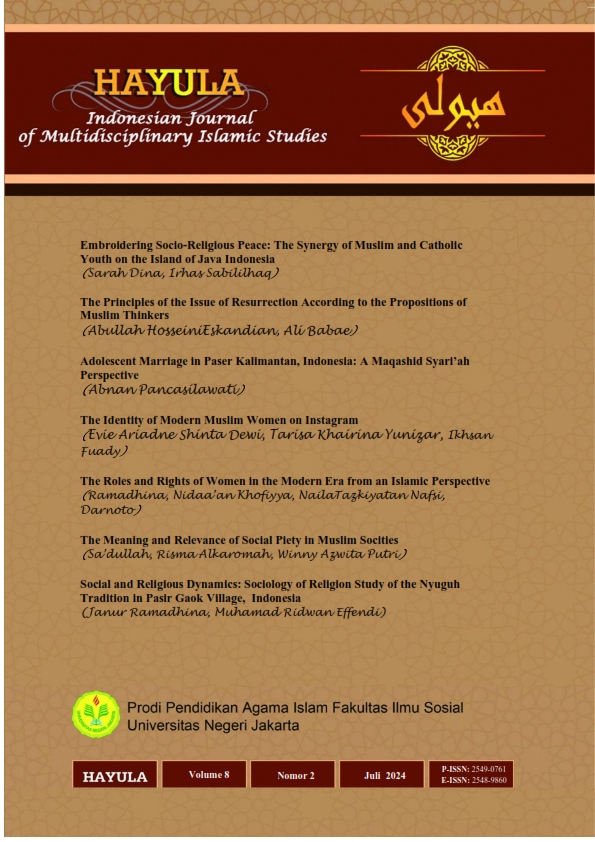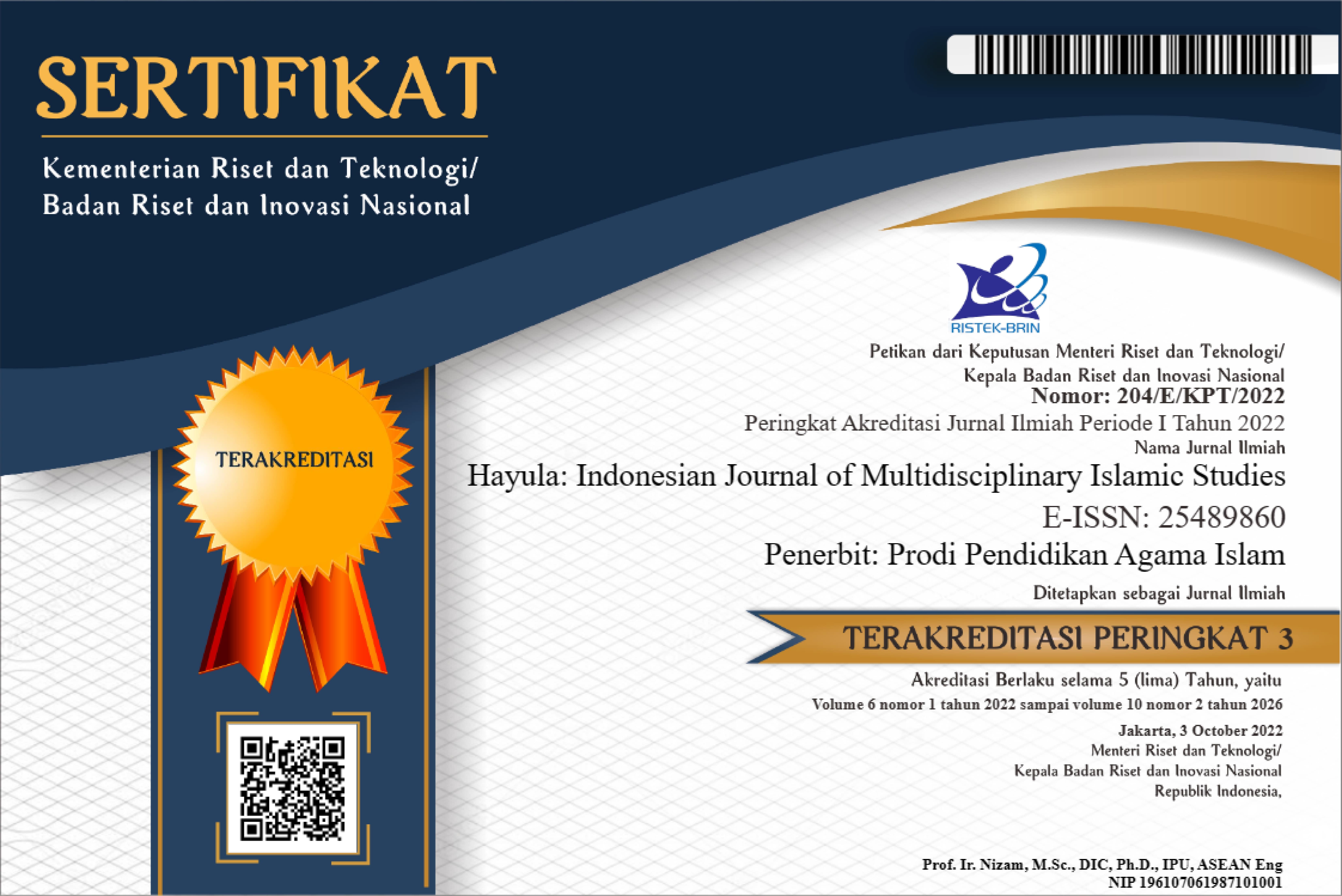The Identity of Modern Muslim Women on Instagram
Studi Fenomenologi tentang Konstruksi Makna Hijab Terhadap Mikro Selebriti
DOI:
https://doi.org/10.21009/hayula.008.02.04Keywords:
Construction of Meaning Hijab, Modern Muslimah Identity, InstagramAbstract
This research aims to uncover the meaning of modern Muslimah identity, which is constructed by micro-celebrities through their accounts on social media such as Instagram. In addition, it also explores the motives that underlie a person to become a celebrity on Instagram. Using a phenomenological approach, data was collected through in-depth interviews with five informants, in addition to literature review and observation. The results revealed that the meaning of Muslimah identity is constructed by Instagram celebrities in three categories, namely: (1) The assertion of the definition of Muslimah is a Muslim woman who follows Islamic law, uses clothing as a cover for the aurat in accordance with Islamic law, the uploaded content displays positive content and does not expose the aurat, and in terms of endorsement, selecting the products received so as not to deviate from Islamic teachings becomes a necessity. (2) The motives of Muslimah celebgrams are divided into two, namely the motive of using Muslimah symbols and the motive of becoming a Muslimah celebgram on Instagram. In using Muslim symbols in the form of hijab, the motive is divided into two, namely the motive of cause and the motive of purpose. (3) Cause motives consists of fulfilling obligations as a Muslimah, encouragement from the family, and encouragement from the environment. The purpose motive consists of fulfilling religious obligations, protecting oneself, breaking the bad stigma against Muslim women, inspiring others, and improving oneself.
References
Baksin, A. (2006). Jurnalistik Televisi: Teori dan Praktik. Bandung: Simbiosa Rekatama Media.
Baulch, E., & Pramiyanti, A. (2018). Hijabers on Instagram: Using Visual Social Media to Construct the Ideal Muslim Woman. Social Media + Society, 1-3.
Beta, A. R. (2014). Hijabers: How young urban muslim women redefine themselves in Indonesia. The International Communication Gazette, 76(4-5), 377-387.
Beta, A. R. (2016). Socially mediated publicness in networked society for Indonesian Muslim women. Jurnal Ilmu Komunikasi, 13(1), 20-27.
Brenner, S. (1996). Reconstructing self and society: Javanese Muslim women and ‘the veil’. American Ethnologist, 23(4), 673-689.
Bucar, E. M. (2016). Secular Fashion, Religious Dress, and Modest Ambiguity: The Visual Ethics of Indonesian Fashion-Veiling. Journal of Religious Ethics, 44(1).
Bullock, K. (2002). Rethinking Muslim Women and the Veil: Challenging Historical & Modern Stereotypes. London: The International Institute of Islamic Thought.
Campbel, T. (1994). Tujuh Teori Sosial. Yogyakarta: Kanisius.
Cooke, M. (2007). The Muslimwoman. Contemporary Islam, 1(2), 139-154.
Creswell, J. W. (2007). Qualitative inquiry & Research Design: Choosing Among Five Approaches (2nd Ed). California: Sage.
F., F., & S, W. (2008). Expressing Islam. Singapore: Institute of Southeast Asian Studies.
Fauzi, E. P., Fasta, F., Nathan, R. J., & Jeong, S. W. (2020). Modern Muslimah in Media: A Study of Reception Analysis in "Salhiha" Program on NET TV. ASPIRATION Journal, 1(2), 137-142.
Forte, J. A. (2004). Symbolic Interactionism and Social Work: A Forgotten Legacy. Families in Society, 521.
Hassim, N. (2014). A Comparative Analysis on Hijab Wearing in Malaysian Muslimah Magazines. SEARCH: The Journal of the South East Asia Research Center for Communications and Humanities, 6(1), 81-85.
Hassim, N. (2014). Hijab and the Malay-Muslim Woman in Media. Procedia - Social and Behavioral Sciences, 428-433.
Hidayat, D. N. (2013). Paradigma dan Metodologi Penelitian Sosial Empirik Klasik. Jakarta: Departemen Ilmu Komunikasi FISIP Universitas Indonesia.
Indarti, & Peng, L.-H. (2016). Modern Hijab Style in Indonesia as An Expression of Cultural Identity and Communication. 2016 International Conference on Applied System Innovation (ICASI), (hal. 1-2). Okinawa.
Indarti, I., & Peng, L. (2016). While they clearly belong to the middle-upper class, these women are able to create codes which large groups of younger Muslim women can identify with: individual style combined with redefined expressions of piety. International Conference on Applied System Innovation (ICASI). Okinawa.
Iskandar. (2008). Metodologi Penelitian Pendidikan dan Sosial (Kuantitatif dan Kualitatif). Jakarta: GP Press.
Jones, C. (2010). Materializing piety: Gendered anxieties about faithful consumption in contemporary urban Indonesia. American Ethnologist, 37, 617-630.
Kuswarno, E. (2009). Fenomenologi. Bandung: Widya Padjajaran.
Machmud, M. (2016). Tuntutan Penulisan Tugas Akhir Berdasarkan Prinsip Dasar Penelitian Ilmiah. Malang: Penerbit Selaras.
Mackenzie, N., & Knipe, S. (2006). Research dilemmas: Paradigms, Methods and Methodology. Issues in Educational Research, 16(2), 198.
Manaf, A. (2018). Konstruksi Nilai Religius oleh Selebgram Hijabers. Skripsi Ilmu Komunikasi Universitas Padjajaran.
Mead, G. H. (1934). Mind, Self, and Society. Chicago dan London: The University of Chicago Press.
Mekarisce, A. A. (2020). Teknik Pemeriksaan Keabsahan Data pada Penelitian Kualitatif di Bidang Kesehatan Masyarakat. Jurnal Ilmiah Kesehatan Masyarakat, 12(3), 147.
Meng, B. (2012). Underdetermined globalization: Media con- sumption via P2P networks. International Journal of Communication, 6, 468-479.
Miles, M. B., Huberman, A. M., & Saldana, J. (2014). Qualitative Data Analysis: A Methods Sourcebook, Third Edit. United States of America: SAGE Publications, Inc.
Moleong, L. J. (2004). Metodologi Penelitian Pendidikan Kualitatif. Bandung: PT Remaja Rosdakarya.
Moleong, L. J. (2012). Metodologi Penelitian Kualitatif. Bandung: PT Remaja Rosdakarya.
Moustakas, C. (1994). Phenomenological Research Methods. Thousand Oaks, California: Sage.
Mulyana, D. (2005). Ilmu Komunikasi Suatu Penganta. Bandung: PT Remaja Rosdakarya.
Naaman, M., Boase, J., & Lai, C.-H. (2010). Is it Really About Me? Message Content in Social Awareness Streams. Proceedings of Sociology.
Schutz, A. (1962). Collected papers Vol. I. The problem of social reality. The Hague: Martinus Nijhoff, 1.
Schutz, A. (1972). The Phenomenology of The Social World. London: Heinemann Educational Book, 1972.
Slama, M., & Barendregt, B. (2018). Introduction: Online publics in Muslim Southeast Asia: In between religious politics and popular pious practices. Asiascape: Digital Asia, 5, 4-28.
Smith-Hefner, N. J. (2007). Javanese women and the veil in Post-Soeharto Indonesia. The Journal of Asian Studies, 66(2), 389.
Sugiarto, E. (2017). Menyusun Proposal Penelitian Kualitatif: Skripsi dan Tesis. Yogyakarta: Suaka Media.
Sugiyono. (2017). Metode Penelitian Pendidikan (Pendekatan Kuantitatif, Kualitatif Dan R&D). Bandung: Alfabeta.
Warren, S. (2018). #YourAverageMuslim: Ruptural geopolitics of British Muslim women’s media and fashion. Political Geography, 118-129.
West, R. (2008). Pengantar Teori Komunikasi: Analisis dan Aplikasi Buku. Jakarta: Salemba Empat.
Downloads
Published
How to Cite
Issue
Section
License
Authors who publish with this Journal agree to the following terms:
- Author retain copyright and grant the journal right of first publication with the work simultaneously licensed under a creative commons attribution licensethat allow others to share the work within an acknowledgement of the work’s authorship and initial publication of this journal.
- Authors are able to enter into separate, additional contractual arrangementfor the non-exclusive distribution of the journal’s published version of the work (e.g. acknowledgement of its initial publication in this journal).
- Authors are permitted and encouraged to post their work online(e.g. in institutional repositories or on their websites) prior to and during the submission process, as it can lead to productive exchanges, as well as earlier and greater citation of published works.
Users/public use of this website will be licensed to CC BY







